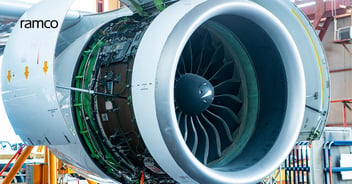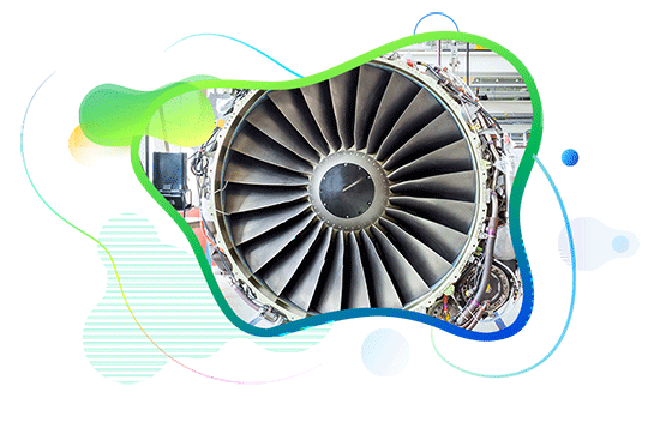
COVID-19 accelerates Digital Transformation in Aviation Maintenance organizations
Published :
.png?length=900&name=MicrosoftTeams-image%20(12).png)
Every crisis brings along with it changes that will last forever, and it is up to us to either succumb to these changes or turn them into opportunities. The pandemic is changing pretty much everything we do, and aviation maintenance is no exception. In this article, let us look at how Aircraft maintenance has changed since the outbreak of this pandemic and what lies ahead.
When it comes to digital transformation in the Aviation industry, MROs and maintenance departments have lagged when compared to other players like Aircraft and Engine OEMs. Even though digital technology solutions and processes allow Airlines and MROs to take advantage of the rapid advances in technology, there have always been challenges in terms of regulations, people, and culture.
In some cases, these initiatives were not given due importance and priority and were pushed back. But these hurdles started to fade away when COVID-19 pandemic forced these organizations and regulators to find ways to support the new working models such as social distancing and remote working norms. Here are some of the notable ones.
For long, Aircraft maintenance via remote inspection was seen as a taboo, and it has always been important to have the LLF (Look, Listen and Feel) component, but COVID-19 has broken that rule. The Federal Aviation Administration (FAA) announced a policy, numbered PS-AIR-21-1901, in March which allows video links and other remote technology to help conduct inspections and validate regulatory compliance.
This policy provides information on the use of remote technology to perform prototype conformity inspections, engineering and ground tests, engineering compliance inspections, production conformity inspections, and inspections for the issuance of an Authorized Release Certificate, FAA Form 8130-3, and Airworthiness Approval Tag.
While this policy is not binding but only optional, I think this is here to stay as the benefits due to remote inspection are phenomenal. Not only does it save huge amounts of cost and time but it also enables more comprehensive inspections, of parts and components. And wait! Drones are now a part of these inspections!
Also Read: How Airlines Can withstand COVID-19 crisis
Another area which has changed the way people work is – collaboration. Aircraft maintenance is a collaborative task where technicians, engineers, and other professionals across various departments like tech services, stores, etc. work together to ensure the safety of every flight. The technology and platforms on which they would usually collaborate included phone calls, emails, or any other social media messaging apps. This generally made it difficult for everybody to be on the same platform during work hours and increased the burden to access hardware, while working on an aircraft.
Remote collaboration tools come to the rescue of such aircraft professionals during these times. In line with the scenario, we recently introduced a Remote collaboration tool, integrated within Ramco’s Mechanic Anywhere mobile app, which facilitates interaction between the various departments in an MRO organization who are using Ramco’s M&E MRO Software.
The tool lets each other interact electronically, through instant messages, screen share, or even voice or video calls. Remote collaboration can help a technician seek assistance from his colleague, assist a supervisor on certain special business operations and even help the technical services team review the latest revisions in an MPD or Task Card with the maintenance team.
Through this remote collaboration tool, the entire company is connected to each other on a single Aviation ERP platform, sharing ideas, discussing topics, and finishing the work faster, thus improving the overall operational efficiency. Here is a quick video of how it works.
Remember how we try on T-shirts before buying it, even it cost us only $10? What if someone needs to buy a million-dollar aircraft, without even getting a glimpse of it, directly? Well, this is actually happening these days.
In the early days of the pandemic, Turkish budget carrier Pegasus Airlines purchased three Airbus A320neo-family jets through the remote process – called ‘e-Delivery’ by the Airbus– which combines a delegated technical acceptance completion with an electronic transfer-of-title, before the aircraft is picked up for ferry, either by the customer or a third party.
This remote delivery mechanism may very well work in the realm of aircraft maintenance as well where aircraft could be delivered after the virtual inspection. The process is efficient offering cost-savings through reduced travel, accommodation expenses and elimination of the need for a customer’s key personnel to leave their workplace. All these benefits would mean that remote aircraft maintenance is likely to become a regular option and will be widely accepted.
Using e-signatures in aircraft maintenance has been a practice even before the pandemic. Few forward-looking organizations have already implemented it as a part of their larger digital strategy, which seeks to eliminate paper in its operations.
For example, Ramco’s customer, Canada's leading specialty aircraft operator, Conair, recently marked one year of paperless operations with Ramco Anywhere Apps. Now the combined effect of remote working, social distancing and regulatory guidelines has accelerated the need for maintenance organizations to adapt to e-signature facility which takes away time-consuming activities associated in terms of big data entry, re-entry of incorrect information, and search and retrieval activities.
To summarize, like I mentioned in the very beginning, COVID-19 brought in the changes that are for good and are here to stay. These changes may be triggered by the current needs but they will make way for a better future in aviation.
Enterprise asset management (EAM) involves the management of mission critical assets of an organization throughout each asset's lifecycle. EAM is used to plan, optimize, execute, and track the needed maintenance activities with the associated priorities, skills, materials, tools, and information. The aim is to optimize the quality and utilization of assets throughout their lifecycle, increase productive uptime and reduce operational costs.
Enterprise asset management (EAM) involves the management of the maintenance of physical assets of an organization throughout each asset's lifecycle. EAM is used to plan, optimize, execute, and track the needed maintenance activities with the associated priorities, skills, materials, tools, and information.
The software helps in effective maintenance of assets through preventive, predictive, shutdown and breakdown maintenance strategies. The system also helps enterprises mitigate equipment risks by enhanced safety standards. The streamlined operations and improved asset performance helps organizations increase their investment effectiveness.
EAM is important because it helps organizations track, assess, manage and optimize asset quality and reliability. Asset intensive Organizations have hundreds, thousands, even millions of assets which needs to be maintained to maximize / optimize life of these assets to increase the return on investment.
The key features of effective EAM are:
Asset Intensive companies under the following Industries :
Contact us for a meeting and schedule a demo
This differs on case to case basis, based on the type of installation and unique industry specific requirements. Contact us for a meeting and schedule a demo.
This differs on case to case basis, based on the type of installation and unique industry specific requirements. Contact us for a meeting and schedule a demo.
Stay Connected, follow us on LinkedIn / Twitter to know more about EAM Software latest trends.

Prakash Babu Devara is Head of Aviation Marketing at Ramco Systems, bringing over 15 years of experience in marketing and branding. With a passion for aviation and technology, he is dedicated to bringing the best of both worlds together to drive value proliferation. Prakash has a proven track record in developing and implementing effective marketing strategies, building strong brands, and driving business growth. In addition to his role at Ramco, he is an aviation blogger and a seasoned public speaker known for communicating complex ideas clearly and engagingly.

All Rights Reserved. © Copyright 2024. Ramco Systems.